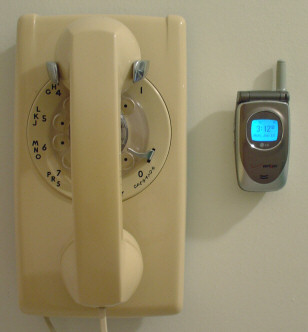Just Thought I’d Call to Say
Telephones, telecommunications, telephone conversations, telemarketers, and even televangelists have become a part of our everyday lives. Like the refrigerator, television, and increasingly the computer, phones are a simple part of everyday life. Few recall (and even fewer care to imagine) what life was like before one’s neighbors were merely a handset away, or when that handset failed to successfully connect. “Only one in 50 …” of the people in the 2000 census did not have a telephone in their homes (Detroit News). So, how has a device with such a stunning impact on our business, consumer, and social lifestyles changed over the years? And, more importantly, how has it changed us?
What I find most surprising is the speed at which the phone has evolved. It has transformed itself from a purely mechanical rotary device (in the early 70s) to a mobile, miniature, multi-featured communication device reminiscent of the communicators on Star Trek. In contrast, thirty or forty years ago, the fridge was still a fridge. Granted, it broke down a little more, lacked a nifty automatic icemaker, and maybe did not defrost itself, but it still was, at the most basic level, a compressor/coolant system hooked up to an insulated box. In contrast, phones have completely re-invented themselves, and to a certain extent, their place in society.

Like any new technology, the phone began, and remained, a novel and relatively expensive technology for a pretty long time. Vague time frame, I know, but let us look to the exciting stuff. In the 1970s, old technology was challenged, and ways to dial free long distance were discovered. The evolution of touch-tone phones eliminated these early hackers, but the part of the general public still remains convinced that hacking phones is still possible (more on that in a minute). “Great,” you say, “but the phone is still plugged into the wall. True, the internal circuitry is different, but what is the big deal?” Good question, and I think you know where this is going.
Cell phones have again changed the communication landscape. In the 1970s, a group was asked to think of ways to improve the telephone. Examples they came up with included phones that could “follow you around” and could “tell you who was calling.” Now, in 2004, we have phones that, in fact, do follow us around and can tell us who is calling. In classic American style, people are once again looking for a way to beat the system. Regardless, the phone has launched itself off of our wall and into our cars, purses, briefcases, movie theaters, and churches. It is certainly an advancement in technology, the ability to be available for contact and anytime, anywhere. However, I do wonder how much connectivity people will put up with. It has already been shown that cell phone use directly correlates with high rates of automobile accidents. It is hard to estimate the impact that this technology will have on our lives. Technology hanging on the wall is one thing, but when it becomes a part of every waking moment of our lives, we should take a moment and question the trends. The evolution of the telephone is something remarkable, but we should think twice before taking the first step towards being constantly “wired” human beings.